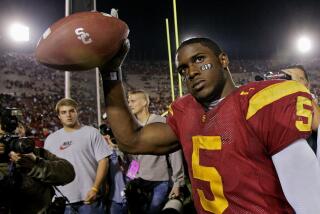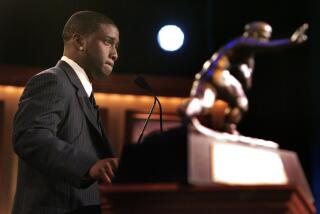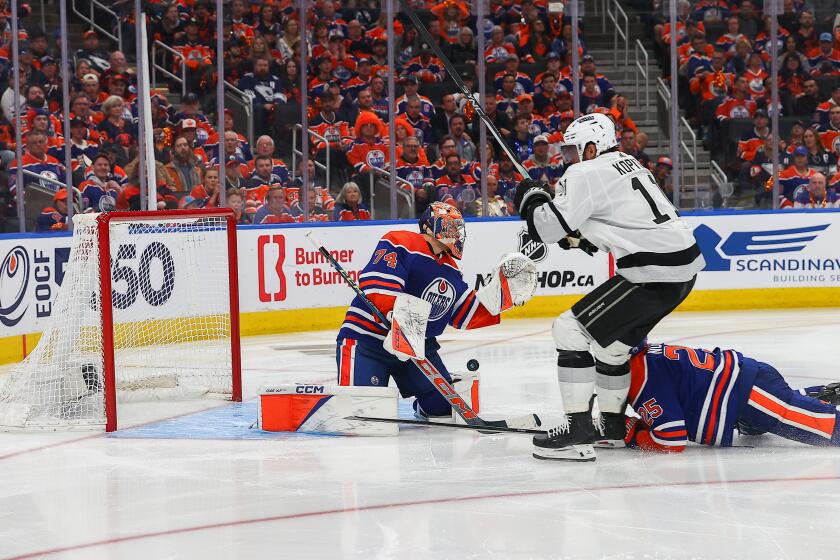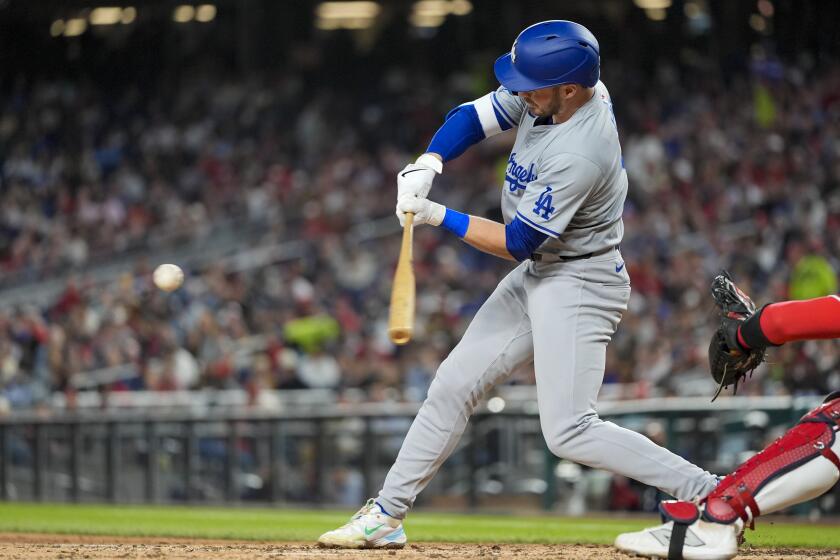Rashaan Salaam, Heisman winner from S.D., dead at 42
Rashaan Salaam accomplished the improbable, rising from playing 8-man football at La Jolla Country Day to becoming the fourth San Diegan to win the Heisman Trophy in 1994.
It was Salaam’s greatest achievement, earned barely two months beyond his 20th birthday, and one that he candidly admitted in the ensuing years he couldn’t match.
Likable, outgoing and engaging, Salaam walked through much of his life with a smile, but the facade may have hid something darker.
On Monday night at a neighborhood park in Boulder, Colo., where Salaam played college football for the University of Colorado, the 42-year-old was found dead. In an interview with USA Today, Salaam’s mother, Khalada, said Boulder police told her they suspected suicide and found a note.
“They said they found a note and would share that with us when we get there,” Salaam’s mother said.
Salaam — who lived in Superior, Colo., about eight miles southeast of Boulder — went to Colorado after a standout career at La Jolla Country Day. He won the Heisman Trophy in his junior season after rushing for 2,055 yards. He also captured the Doak Walker Award as the nation’s top running back.
“Obviously, he was a La Jolla Country Day legend and a San Diego legend,” LJCD Athletic Director Jeff Hutzler said. “To lose anybody at 42 years of age, football great or not, is difficult.”
Remarkably, among the last 54 winners of the Heisman, dating back to Terry Baker in 1962, Salaam is the first to die.
Salaam’s last post on Facebook was on the Sunday after Thanksgiving, Nov. 27, and featured a link to a video featuring Whitney Houston, Luther Vandross, Dionne Warwick and Stevie Wonder singing, “That’s What Friends Are For.” Salaam wrote that he was “feeling joyful” and added, “Keep smiling.”
Sean Saadeh, who was Salaam’s quarterback at LJCD, remembered him Tuesday as a “friendly and dynamic guy. Always happy.
“I felt blessed every day to be able to play with a guy like him. He was such a special player, we always knew he was going to do great things at a higher level.”
To see a teammate from his 8-man team capture the Heisman was “surreal,” Saddeh said.
“But it didn’t really surprise me,” he added, “because he was such a great talent and such a hard worker.”
Salaam turned pro after his Heisman season and was a first-round draft choice of the Chicago Bears. He gained 1,074 yards and scored 10 touchdowns in his first year and was named NFC Rookie of the Year in 1995. But he wound up playing just three seasons for the Bears.
In 1999, Salaam admitted a marijuana addiction contributed to his career downfall. He lost 14 fumbles in 31 games and told ESPN he thought the issue was related to marijuana.
“It probably had me out there lackadaisical instead of being out there 100 percent,” he said then. “Everybody thinks getting high is cool, you can let it go when you want to let it go. But it’s just as potent as alcohol. It’s just as potent as cocaine.”
Salaam broke his leg in the third game of the 1997 season and said the injury increased his addiction.
“When I got hurt, I knew it was a problem because it pretty much consumed all my time,” he said. “I wasn’t going to practice or anything like that so I pretty much spent my time sitting around getting high, and that’s when I knew I had to let it go.”
Salaam also told ESPN he entered a rehabilitation program early in 1998. Later that year he was released by the Bears.
“It was hard,” he said. “It was embarrassing. My pride was shot. It was just a nightmare to be 23 years old and out of football. I couldn’t believe what was going on.”
In 1999, Salaam had a training camp stint with the Oakland Raiders and later joined the Cleveland Browns, but played in just two games before he was cut.
In 2001, Salaam re-emerged in the XFL, the pro league that lasted one season. He played for Memphis, averaging 4.6 yards per carry while scoring five TDs. But even that season was shut down because of a shoulder injury.
The Memphis GM was former Chargers GM Steve Ortmayer. In an interview with the San Diego Union-Tribune in 2003, Ortmayer said of Salaam, “I’m a big supporter. It’s a complete mystery to me that he’s not with an NFL team.”
Salaam attempted another comeback in 2003, moving from San Diego to Boca Raton, Fla., to work out at Chris Carter’s FAST Program. After ballooning to 240 pounds, he worked himself down to 220 and contended he was in the best shape of his life.
“It isn’t about the money,” Salaam said in a 2003 interview with the Union-Tribune. “My heart says it’s not over for me. I want to play in the NFL again.”
He never had another chance with an NFL team.
In the ‘03 Union-Tribune interview, Salaam said the money from his original $3.8 million NFL contract had been “safely” invested. However, in 2011, the Denver Post reported Salaam sold his Heisman Trophy ring, through an auction house, for $8,140. The ring was said to have several diamonds, but was missing one.
In a December 2014 story, the Denver Post interviewed Salaam and reported he was working in the Boulder community and “teaching kids the story of what made Rashaan Salaam so great, and what made Rashaan Salaam a what-if.”
“Ever since he came back, he’s been willing to do whatever we’ve asked him to do to represent the school,” David Plati, CU’s associate athletic director, sports information, told the Post. “We honored him at the UCLA game. He was the marshal of the homecoming parade.”
Salaam has been on the ballot for the College Football Hall of Fame since 2014. The 2017 class will be announced Jan. 6.
Salaam was the second of San Diego’s four Heisman Trophy winners, following Lincoln’s Marcus Allen (1981) and preceding Patrick Henry’s Ricky Williams (1998) and Helix’s Reggie Bush (2005).
Salaam grew up in San Diego’s Skyline neighborhood and his mother had to be convinced to let him play football because she wanted him to focus on academics. But football also was in Rashaan’s blood. His father was Teddy Washington, a talented running back who played at San Diego State in 1966-67.
The parents converted to the Islamic faith, and the mother became Khalada Salaam-Alaji and the father Sultan Abdus-Salaam. They later divorced and Salaam-Aljai gained full custody of Rashaan. She remarried.
Rashaan attended Bell Junior High in ninth grade, but when his mother didn’t like the friends he was making she decided to send him to La Jolla Country Day, a nearly all-white school that was 15 miles and a two-hour bus ride from Skyline. Rashaan cried the first day. He wanted to play football with his friends at inner-city Morse.
On the first day at LJCD, Rashaan met Rick Woods, the football coach who would become a mentor and father figure. Woods saved Rashaan the long bus ride by taking him to school, and the two would team up to help Salaam become one of the greatest running backs in county history.
A sizable high school back at 6-foot-1, 215 pounds, Salaam scored a California high school-record 50 TDs in his junior season while rushing for 2,164 yards (18.8 per carry). In 2½ seasons, he compiled nearly 5,000 yards (4,965) and scored 112 touchdowns.
“For 8-man, he was unstoppable,” said Steve Brand, a Union-Tribune sportswriter who covered Salaam. “I recall a game against Francis Parker when he took the kickoff 50 yards before being pushed out of bounds. The Parker players reacted like they had just won the game because they actually stopped him from scoring.”
Still, Salaam always had to contend with the ribbing from his friends that it was “only” 8-man football he played. He would say later that he deeply resented it, while also admitting that his mom probably made the right choice for him.
“I guess Mom knows best,” he told the Union-Tribune. “Football-wise, I resent it. Socially, I do a little. But I got a good education there and learned how to deal with different people and different races.”
The 8-man background didn’t matter one bit during Salaam’s spectacular career at Colorado.
In his Heisman Trophy season, Salaam — who wore wristbands with “Skyline” written on them — ran for 259 yards in his final game to become the fourth running back in Division I-A history to run for more than 2,000 yards in one year.
He had a 317-yard game earlier in the season on a sweltering day at Texas, and after rushing for 166 yards the following week against Missouri, Salaam addressed his Heisman chances for the first time.
“It’s a big joke,” he said. “The last few people who have won it haven’t done anything after getting it. If I get the Heisman, I’ll be upset.”
A couple of months later, Salaam offered a completely different tone — one of humility — when he was announced as the Heisman winner in New York. He beat out, in order, Penn State running back Ki-Jana Carter, Alcorn State quarterback Steve McNair, Penn State quarterback Kerry Collins, Miami defensive tackle Warren Sapp and Alabama quarterback Jay Barker.
“I feel blessed,” Salaam said before a national television audience.
“This is just a trophy,” he would say later in the evening. “I’m not going to let it turn my life around. I’m still Rashaan. I’m still going to hang out with my friends. The Heisman Trophy has my name on it, but that’s the end of it.”
tod.leonard@sduniontribune.com
UPDATES:
1:45 p.m. and 5:30 p.m.: This article was updated with additional details.
More to Read
Get our high school sports newsletter
Prep Rally is devoted to the SoCal high school sports experience, bringing you scores, stories and a behind-the-scenes look at what makes prep sports so popular.
You may occasionally receive promotional content from the Los Angeles Times.







